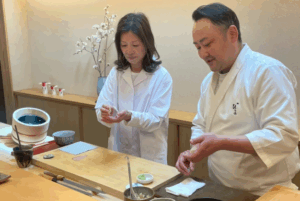【The Soul of Sushi】A Pro's Guide to the Science and Art of Perfect Shari (Sushi Rice)
Introduction ー It's Not About the Fish
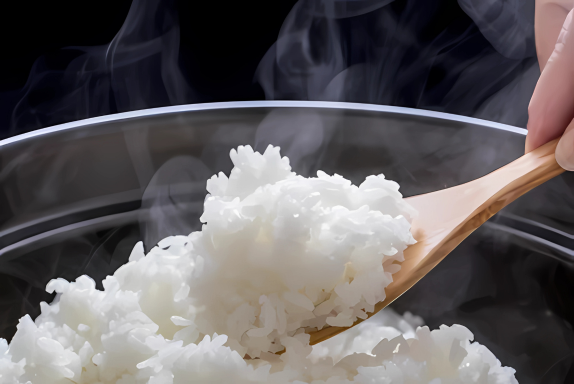
Many people believe that the star of sushi is the fish, the neta. But for a true sushi master, that is a fundamental misunderstanding. The real soul of sushi, the element that separates the good from the sublime, is the rice—the shari.
Welcome to a deep dive into the world of shari. This isn't just a recipe; it's a journey into the science, art, and philosophy that transforms simple rice into the foundation of world-class sushi. Here at FUKUOKA WASHOKU SCHOOL, our head instructor, Mr. Taichi Hirano, believes that to master sushi, one must first master the shari. Today, we share a glimpse into that professional world.
The Foundation - Why Rice Selection is Everything
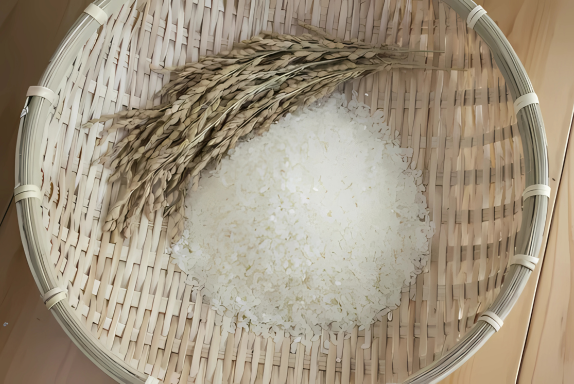
The journey to perfect shari begins long before the water boils. It starts with selecting the right grain. In a Japanese supermarket, you'll be faced with countless options, but a professional's choice is deliberate and precise.
・The Ideal Profile
For sushi, we seek rice that is less sticky than typical table rice. The grains should be firm enough to hold their shape, yet tender enough to gently separate in your mouth. This is why varieties like.
"Sasanisiki" or "Akitakomachi" are often preferred by chefs.
・The "Koshihikari" Paradox
While "Koshihikari" is one of Japan's most famous and delicious rice varieties, its characteristic stickiness and strong flavor make it less suitable for shari. It can become too dense and overwhelm the delicate balance with the vinegar and topping.
・The Pro's Secret - "Old Rice" (古米)
Some high-end sushi restaurants prefer to use rice that has been aged for a year. This "old rice" has a lower moisture content, which allows it to absorb the sushi vinegar more evenly without becoming mushy, resulting in a perfect texture.
The Ritual of Preparation - Washing and Cooking with Purpose
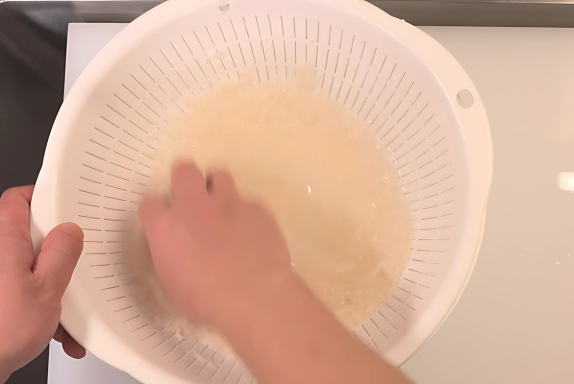
How you wash and cook the rice is a meticulous ritual, where every step has a scientific reason.
1,Washing (研ぎ - Togi)
The goal isn't to scrub the rice, but to gently polish it. We use cold water, as warm water can cause the grains to crack and absorb the starchy bran flavor. With gentle, circular motions, we wash the rice until the water runs almost clear. This removes excess surface starch, preventing a gummy texture.
2,Soaking (浸水 - Shinsui)
After washing, the rice is soaked in clean, cold water for 30-60 minutes. This crucial step allows each grain to absorb water to its core, ensuring it cooks evenly and fluffy.
3,Cooking (炊飯 - Suihan)
Professionals pay close attention to water quality, preferring soft water to avoid minerals that can affect the taste. The ratio is critical; typically 1 part rice to 1.1 or 1.2 parts water. After cooking, the rice is left to steam, untouched, for another 10-15 minutes. This allows the moisture to distribute perfectly throughout every single grain.
The Alchemist's Touch - The Science of Sushi Vinegar (Awasezu)
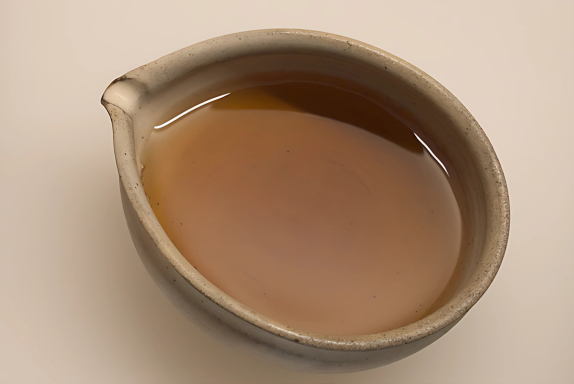
The vinegar mixture, or awasezu, is what breathes life into the cooked rice. While recipes vary, the choice of vinegar itself is a mark of a chef's style.
・The Rise of Red Vinegar (赤酢 - Akazu)
Traditionally, rice vinegar was used. However, many top Edomae-style sushi restaurants now use akazu, or red vinegar. Made from aged sake lees (the sediment from sake production), akazu has a milder acidity, a deeper, more complex umami flavor, and a rich fragrance. It gives the shari a slightly brownish hue and a character that beautifully complements fatty fish like tuna.
・A Professional Base Recipe
Here is a foundational recipe for our school's shari, using this prized red vinegar.
For 1 'go' (150g) of rice:
- Red Vinegar (Akazu): 40cc
- Sugar: 8g
- Salt: 2g
For 2 'go' (300g) of rice:
- Red Vinegar (Akazu): 80cc
- Sugar: 15g
- Salt: 4g
Combine the vinegar, sugar, and salt, mixing until fully dissolved. This can be made in advance.
The Climax - The Art of Mixing ("Shari-kiri")
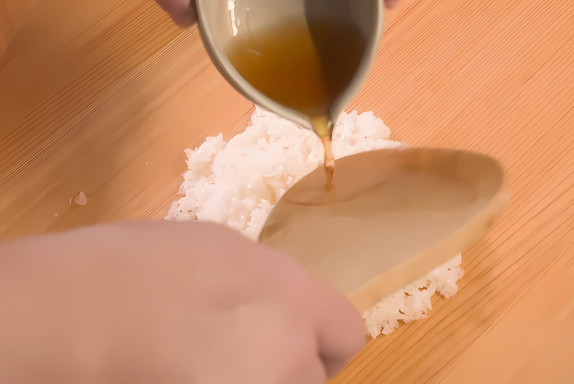
This is where technique and tradition unite. The mixing process, known as shari-kiri (rice-cutting), is performed in a specific way for specific reasons.
1,The Wooden Tub (飯切 - Hangiri)
The freshly cooked, steaming rice is immediately transferred to a large, shallow wooden tub called a hangiri. Why wood? The porous, uncoated wood absorbs any excess moisture from the rice and vinegar, preventing the shari from becoming waterlogged—a feat a metal or plastic bowl cannot achieve.
2,The "Cutting" Motion
The prepared vinegar is drizzled over the hot rice. Using a flat rice paddle (shamoji), the chef uses swift, slicing motions to separate and coat every grain, rather than stirring or pressing. This "cutting" motion prevents the delicate grains from being smashed.
3,Rapid Cooling
Simultaneously, the rice is fanned. This rapid cooling process does two things: it gives the shari a beautiful, glossy sheen and it stops the vinegar from "cooking" the rice further.
4,The Perfect Temperature
The final, ideal temperature for shari is hitohada—about human body temperature. Why? This gentle warmth is the perfect temperature to slightly melt the fat of the fish topping the moment it enters your mouth, releasing its full, rich flavor and creating a seamless, melt-in-your-mouth experience.
【Conclusion】Shari is More Than Rice—It's a Philosophy
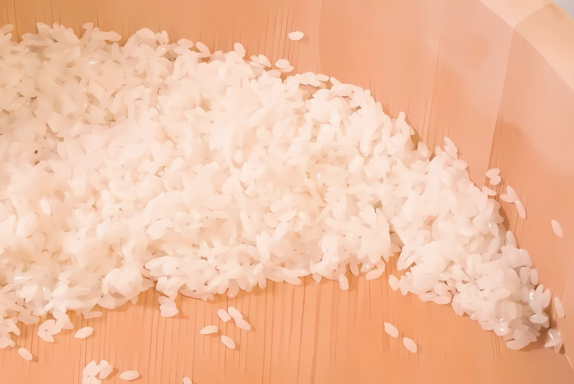
As you can see, a perfect bowl of shari is no accident. It is the result of scientific knowledge, precise technique, and a deep respect for the ingredients. It embodies the sushi craftsman's philosophy: every detail matters, and there are no shortcuts to excellence. This dedication is the true soul of sushi.
Take Your Passion to the Next Level
For the Aspiring Professional
Did this deep dive into the world of shari ignite your passion? This is just one part of the vast knowledge required to become a true sushi professional. In our comprehensive online school, you will learn everything from fish preparation and knife skills to creating a full "Omakase" course, all under the direct guidance of Mr. Hirano. Start your journey to becoming a sushi chef today.

For the Curious Traveler
Want to feel this philosophy firsthand? To taste shari made with this level of care and learn from a master in person? Join our exclusive Sushi Making Experience in historic Dazaifu, Fukuoka. It's more than a meal; it's https://washoku-school.com/sushi-experience-program-new/an unforgettable cultural immersion.


